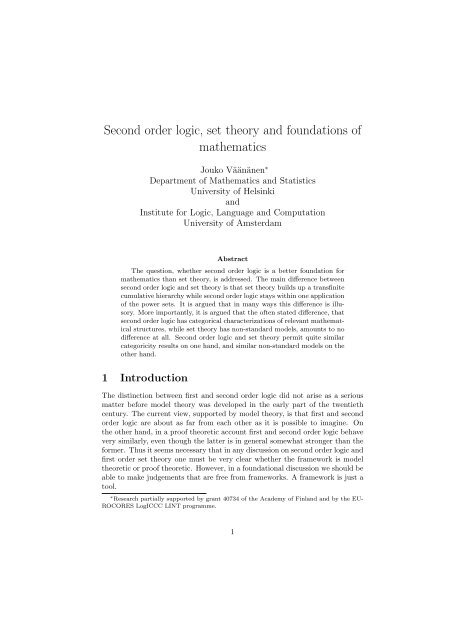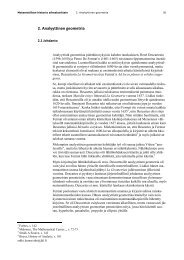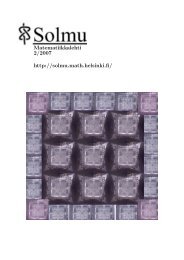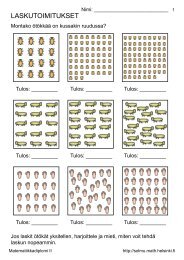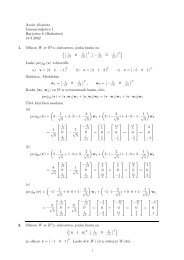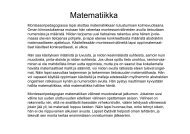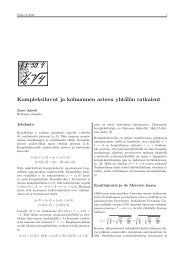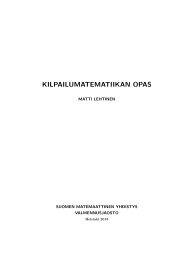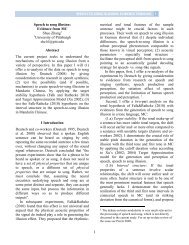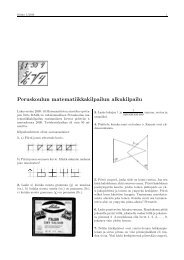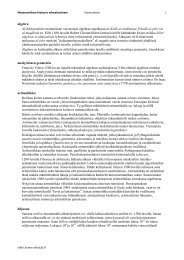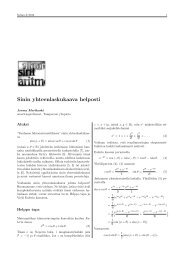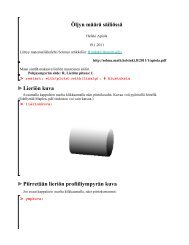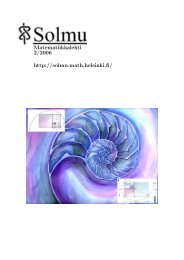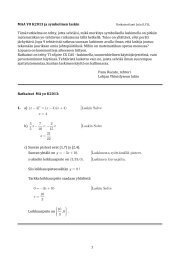Second order logic, set theory and foundations of mathematics
Second order logic, set theory and foundations of mathematics
Second order logic, set theory and foundations of mathematics
You also want an ePaper? Increase the reach of your titles
YUMPU automatically turns print PDFs into web optimized ePapers that Google loves.
<strong>Second</strong> <strong>order</strong> <strong>logic</strong>, <strong>set</strong> <strong>theory</strong> <strong>and</strong> <strong>foundations</strong> <strong>of</strong><br />
<strong>mathematics</strong><br />
Jouko Väänänen ∗<br />
Department <strong>of</strong> Mathematics <strong>and</strong> Statistics<br />
University <strong>of</strong> Helsinki<br />
<strong>and</strong><br />
Institute for Logic, Language <strong>and</strong> Computation<br />
University <strong>of</strong> Amsterdam<br />
Abstract<br />
The question, whether second <strong>order</strong> <strong>logic</strong> is a better foundation for<br />
<strong>mathematics</strong> than <strong>set</strong> <strong>theory</strong>, is addressed. The main difference between<br />
second <strong>order</strong> <strong>logic</strong> <strong>and</strong> <strong>set</strong> <strong>theory</strong> is that <strong>set</strong> <strong>theory</strong> builds up a transfinite<br />
cumulative hierarchy while second <strong>order</strong> <strong>logic</strong> stays within one application<br />
<strong>of</strong> the power <strong>set</strong>s. It is argued that in many ways this difference is illusory.<br />
More importantly, it is argued that the <strong>of</strong>ten stated difference, that<br />
second <strong>order</strong> <strong>logic</strong> has categorical characterizations <strong>of</strong> relevant mathematical<br />
structures, while <strong>set</strong> <strong>theory</strong> has non-st<strong>and</strong>ard models, amounts to no<br />
difference at all. <strong>Second</strong> <strong>order</strong> <strong>logic</strong> <strong>and</strong> <strong>set</strong> <strong>theory</strong> permit quite similar<br />
categoricity results on one h<strong>and</strong>, <strong>and</strong> similar non-st<strong>and</strong>ard models on the<br />
other h<strong>and</strong>.<br />
1 Introduction<br />
The distinction between first <strong>and</strong> second <strong>order</strong> <strong>logic</strong> did not arise as a serious<br />
matter before model <strong>theory</strong> was developed in the early part <strong>of</strong> the twentieth<br />
century. The current view, supported by model <strong>theory</strong>, is that first <strong>and</strong> second<br />
<strong>order</strong> <strong>logic</strong> are about as far from each other as it is possible to imagine. On<br />
the other h<strong>and</strong>, in a pro<strong>of</strong> theoretic account first <strong>and</strong> second <strong>order</strong> <strong>logic</strong> behave<br />
very similarly, even though the latter is in general somewhat stronger than the<br />
former. Thus it seems necessary that in any discussion on second <strong>order</strong> <strong>logic</strong> <strong>and</strong><br />
first <strong>order</strong> <strong>set</strong> <strong>theory</strong> one must be very clear whether the framework is model<br />
theoretic or pro<strong>of</strong> theoretic. However, in a foundational discussion we should be<br />
able to make judgements that are free from frameworks. A framework is just a<br />
tool.<br />
∗ Research partially supported by grant 40734 <strong>of</strong> the Academy <strong>of</strong> Finl<strong>and</strong> <strong>and</strong> by the EU-<br />
ROCORES LogICCC LINT programme.<br />
1
When second <strong>order</strong> <strong>logic</strong> is thought <strong>of</strong> as a foundation <strong>of</strong> <strong>mathematics</strong>, it<br />
is nowadays taken in the model theoretic sense with reference to its power to<br />
characterize classical mathematical structures up to isomorphism <strong>and</strong> thereby<br />
capture our intuition in an exact way. This is <strong>of</strong>ten contrasted to the situation<br />
with the model <strong>theory</strong> <strong>of</strong> <strong>set</strong> <strong>theory</strong>, where the first <strong>order</strong> Zermelo-Fraenkel<br />
axioms have countable models <strong>and</strong> models with non-st<strong>and</strong>ard integers, contrary<br />
to our intuition about the <strong>set</strong> theoretic universe. So the huge distance between<br />
the model <strong>theory</strong> <strong>of</strong> second <strong>order</strong> <strong>logic</strong> <strong>and</strong> the model <strong>theory</strong> <strong>of</strong> first <strong>order</strong> <strong>logic</strong><br />
manifests itself in discussions about <strong>foundations</strong> <strong>of</strong> <strong>mathematics</strong>, with second<br />
<strong>order</strong> <strong>logic</strong> appearing to emerge as the <strong>logic</strong> which more accurately captures the<br />
intended meaning <strong>of</strong> mathematical concepts.<br />
I will argue below that despite their great apparent differences, second <strong>order</strong><br />
<strong>logic</strong> <strong>and</strong> first <strong>order</strong> <strong>set</strong> <strong>theory</strong> turn out to be virtually indistinguishable as far<br />
as capturing mathematical concepts is concerned.<br />
Another difference between second <strong>order</strong> <strong>logic</strong> <strong>and</strong> <strong>set</strong> <strong>theory</strong> is that the<br />
latter builds up a transfinite power-<strong>set</strong> hierarchy while the former <strong>set</strong>tles with<br />
one layer <strong>of</strong> power-<strong>set</strong>s. This is a genuine difference which, unlike claims <strong>of</strong> categoricity,<br />
cannot be explained away. However, if second <strong>order</strong> <strong>logic</strong> is extended<br />
to third <strong>and</strong> higher <strong>order</strong> <strong>logic</strong>s <strong>and</strong> eventually to type <strong>theory</strong>, this difference to<br />
<strong>set</strong> <strong>theory</strong> becomes respectively smaller. Still type <strong>theory</strong> maintains an explicit<br />
typing <strong>of</strong> objects while <strong>set</strong> <strong>theory</strong> is type-free. On the other h<strong>and</strong>, every <strong>set</strong><br />
has a rank, an ordinal, which more or less works like a type. So the difference<br />
between type <strong>theory</strong> <strong>and</strong> <strong>set</strong> <strong>theory</strong> is really only in that <strong>set</strong> <strong>theory</strong> has an internal<br />
mechanism for generating higher <strong>and</strong> higher types while in type <strong>theory</strong><br />
this is part <strong>of</strong> the <strong>set</strong>-up <strong>of</strong> the language. From the point <strong>of</strong> view <strong>of</strong> foundational<br />
questions this difference seems like a minute one.<br />
2 <strong>Second</strong> <strong>order</strong> <strong>logic</strong><br />
The approach <strong>of</strong> second <strong>order</strong> <strong>logic</strong> to the <strong>foundations</strong> <strong>of</strong> <strong>mathematics</strong> is that<br />
mathematical propositions have the form<br />
A |= φ, (1)<br />
where A is a structure, typically one <strong>of</strong> the classical structures such as integers<br />
or reals, <strong>and</strong> φ is a mathematical statement written in second <strong>order</strong> <strong>logic</strong>. This<br />
seems at least at first sight like an excellent approach since almost any statement<br />
in <strong>mathematics</strong> can be succinctly written as a second <strong>order</strong> property <strong>of</strong> one <strong>of</strong> the<br />
classical structures. An example is provided by Fermat’s Last theorem (where<br />
exponentiation is a defined symbol):<br />
A |= ∀x > 0∀y > 0∀z > 0∀n > 2¬(x n + y n = z n ), (2)<br />
where A = (N, +, ·,
|= θ A → φ. (3)<br />
As was known already in the thirties, the second <strong>order</strong> semantic <strong>logic</strong>al consequence<br />
relation |= ψ is not axiomatizable (i.e. not r.e.). The Levy-hierarchy<br />
[4] <strong>of</strong> <strong>set</strong> <strong>theory</strong> is one possible way to measure how far |= ψ is from being<br />
axiomatizable. As it turns out, |= ψ is Π 2 -complete —<strong>and</strong> thus a fortiori not Σ 2<br />
—in <strong>set</strong> <strong>theory</strong> ([7]). In other words, the only way to become convinced <strong>of</strong> |= ψ<br />
for a given ψ requires, in the unavoidable worst case, going through the entire<br />
<strong>set</strong> theoretical universe in search <strong>of</strong> evidence. To see what this means, suppose<br />
|= ψ is written as ∀x∃yΦ(x, y), where Φ(x, y) is Σ 0 . Then to be convinced <strong>of</strong><br />
the truth <strong>of</strong> |= ψ one has to go through every <strong>set</strong> x <strong>and</strong> then look for y with<br />
Φ(x, y).<br />
The powerful Levy Reflection Theorem [4] says that if Ψ(x, y) is Σ 0 , κ > 0<br />
<strong>and</strong> a 1 , ..., a n ∈ H(κ) 1 such that for some b we have Ψ(b, a 1 , ..., a n ) , then<br />
there is b ∈ H(κ) such that Φ(b, a 1 , ..., a n ). That means that if we are given<br />
a 1 , ..., a n ∈ H(κ) <strong>and</strong> we want to find b such that Φ(b, a 1 , ..., a n ) we need only<br />
look for such a b in H(κ), rather than in the vast universe V <strong>of</strong> <strong>set</strong> <strong>theory</strong>.<br />
So going back to |= ψ <strong>and</strong> its Π 2 -representation ∀x∃yΦ(x, y) we first take an<br />
arbitrary x in the universe <strong>of</strong> <strong>set</strong>s <strong>and</strong> then search for y. The message <strong>of</strong> Levy’s<br />
Reflection Principle is that we only need to look for y in the “neighborhood”<br />
<strong>of</strong> x (in the sense that if x ∈ H(κ), κ > ω, then we only need to look for y in<br />
H(κ)). So the good news is that we only need to hang around x, but the bad<br />
news is that x may be anywhere in the universe V <strong>of</strong> <strong>set</strong>s. For example, there<br />
is no a priori bound on the hereditary cardinality <strong>of</strong> x.<br />
So the difference to |= φ where φ is first <strong>order</strong> is great for in this case we<br />
only need to look for a natural number that codes a pro<strong>of</strong> <strong>of</strong> φ. The difference<br />
is also great to |= φ for φ ∈ L ω1ω, where we only need to look for a real number<br />
that codes a pro<strong>of</strong> <strong>of</strong> φ. Likewise with |= φ for φ ∈ L ω1ω 1<br />
, where we only need 2<br />
to look for <strong>set</strong>s <strong>of</strong> reals that code possible models <strong>of</strong> φ. No matter how badly<br />
behaving L ω1ω 1<br />
otherwise is 3 , at least validity in L ω1ω 1<br />
can be checked without<br />
going further afield than <strong>set</strong>s <strong>of</strong> reals. Not so for second <strong>order</strong> <strong>logic</strong>.<br />
It is true, to check |= φ for second <strong>order</strong> φ it is sufficient to check <strong>set</strong>s <strong>of</strong><br />
hereditary cardinality less than the first supercompact cardinal (<strong>and</strong> nothing less<br />
will do) [5]. This is however a far cry from going through all natural numbers,<br />
going through all reals, or going through all <strong>set</strong>s <strong>of</strong> reals.<br />
What does “going through” mean, for surely we cannot really “go through”<br />
all natural numbers, let alone all reals, or all <strong>set</strong>s <strong>of</strong> reals. It is all a question <strong>of</strong><br />
how to deal with abstract objects, something where <strong>logic</strong> is supposed to help us.<br />
The great thing about natural numbers is that we can “look” at them. We can<br />
take natural numbers one by one <strong>and</strong> check what they are like. We can even<br />
imagine ourselves looking at a real number <strong>and</strong> wondering whether it codes a<br />
1 The <strong>set</strong> <strong>of</strong> <strong>set</strong>s that have hereditary cardinality < κ i.e. are included in a transitive <strong>set</strong> <strong>of</strong><br />
cardinality < κ.<br />
2 Thanks to the Löwenheim-Skolem Theorem <strong>of</strong> L ω1 ω 1<br />
3 For example, its Hanf number can be bigger than the first measurable cardinal [3].<br />
3
pro<strong>of</strong> <strong>of</strong> something or not. But when we come to <strong>set</strong>s <strong>of</strong> real numbers there is<br />
phase transition to something infinitely more complex. We leave the world <strong>of</strong><br />
concrete or almost concrete objects <strong>and</strong> enter the world <strong>of</strong> abstract objects.<br />
The situation with (3) is a little simpler than with (1). In (3) one only has<br />
to search for evidence in the power-<strong>set</strong> <strong>of</strong> A. If A is continuum-sized, then we<br />
have to search through <strong>set</strong>s <strong>of</strong> reals. What was said above about going through<br />
all <strong>set</strong>s <strong>of</strong> reals applies. It is abstract thinking.<br />
The main result <strong>of</strong> Gödel’s doctoral thesis was the Completeness Theorem<br />
for first <strong>order</strong> <strong>logic</strong> which tells us that the semantic <strong>logic</strong>al consequence relation<br />
<strong>of</strong> first <strong>order</strong> <strong>logic</strong> is, in contrast to second <strong>order</strong> <strong>logic</strong>, axiomatizable in the way<br />
suggested by Hilbert <strong>and</strong> Bernays. Thus the combination <strong>of</strong> Gödel’s Completeness<br />
Theorem <strong>and</strong> his Incompleteness Theorem established the sharp difference<br />
between the semantics <strong>of</strong> first <strong>and</strong> second <strong>order</strong> <strong>logic</strong>s. In first <strong>order</strong> <strong>logic</strong> truth<br />
in all models can be reduced to the existence <strong>of</strong> a finite pro<strong>of</strong>. In second <strong>order</strong><br />
<strong>logic</strong> truth in all models cannot be reduced to the existence <strong>of</strong> a finite pro<strong>of</strong> in<br />
any sensible way.<br />
If (1) is the general form <strong>of</strong> a mathematical proposition, then what is the<br />
general form <strong>of</strong> a pro<strong>of</strong> <strong>of</strong> (1) Logicians have a formal concept <strong>of</strong> a pro<strong>of</strong>, but<br />
we can ask more generally what is the basic form or nature <strong>of</strong> something we<br />
can assert that would make asserting (1) legitimate An obvious answer would<br />
seem to be that if we have already grounds to assert<br />
A |= ψ, (4)<br />
<strong>and</strong> we moreover know that every model <strong>of</strong> ψ is a model <strong>of</strong> φ, i.e.<br />
|= ψ → φ, (5)<br />
then we can assert by the <strong>logic</strong>al rule <strong>of</strong> Modus Ponens that (1) holds. But we<br />
just observed that (5) is an even more complex notion than (1). In view <strong>of</strong> our<br />
discussion above there are no rules that completely explain (5) that would be<br />
easier to present <strong>and</strong> use than (1). It is rather the opposite: we can prove in<br />
<strong>set</strong> <strong>theory</strong> that one cannot be convinced <strong>of</strong> (5) without going through the entire<br />
universe <strong>of</strong> <strong>set</strong>s (or at least up to a supercompact cardinal), while one can be<br />
convinced <strong>of</strong> (1) by “just” going through all sub<strong>set</strong>s <strong>of</strong> A.<br />
Of course there are some rules that govern (5), like<br />
|= φ(P ) → ∃Xφ(X)<br />
<strong>and</strong> are used all the time even if it is known that they cannot produce all cases<br />
<strong>of</strong> (5).<br />
There are two stronger versions <strong>of</strong> (3), namely<br />
ZF C ⊢ ∀B(B |= θ A → B |= φ) (6)<br />
<strong>and</strong><br />
CA ⊢ θ A → φ, (7)<br />
4
where CA is the usual axiomatization <strong>of</strong> second <strong>order</strong> <strong>logic</strong> i.e. the comprehension<br />
schema <strong>and</strong> the axiom <strong>of</strong> choice. These two conditions are Σ 0 1-properties <strong>of</strong><br />
φ. Even if one wants to assert the weaker (3) it seems reasonable to give (6) or<br />
(7) as the justification. Indeed, it is the habit <strong>of</strong> mathematicians to aim at the<br />
strongest statements, whenever they seem within reach. Also, one can justify<br />
(6) or (7) by giving a pro<strong>of</strong>, which is a finite object, typically even surveyable,<br />
while justifying (3) without recourse to (6) or (7) involves dealing directly with<br />
infinite objects.<br />
One may ask, whether indeed (3) is ever asserted with certainty without the<br />
certainty arising from knowing (6) or (7). Be this as it may, there is nothing<br />
wrong in believing (3) on the basis <strong>of</strong> (6) or (7), <strong>and</strong> the recourse to (6) or (7)<br />
does not in any way render (3) meaningless.<br />
If we compare (6) <strong>and</strong> (7), we may observe that while (7) may be harder to<br />
prove, (6) certainly gives a shorter pro<strong>of</strong>. In fact, there is no recursive function<br />
h such that the following holds: If φ is a second <strong>order</strong> sentence <strong>and</strong> there is a<br />
pro<strong>of</strong> in ZFC <strong>of</strong> ∀M(M |= φ) with n lines, then there is a pro<strong>of</strong> <strong>of</strong> φ <strong>of</strong> ≤ h(n)<br />
lines from CA. 4<br />
I have called (6) <strong>and</strong> (7) stronger forms <strong>of</strong> (3) because I take it for granted<br />
that ZF C <strong>and</strong> CA are true axioms. It is not the main topic <strong>of</strong> this paper to<br />
investigate how much ZF C <strong>and</strong> CA can be weakened in this or that special<br />
instance <strong>of</strong> (6) <strong>and</strong> (7), as such considerations do not differentiate second <strong>order</strong><br />
<strong>logic</strong> <strong>and</strong> <strong>set</strong> <strong>theory</strong> from each other in any essential way.<br />
It is not easy to give an example <strong>of</strong> a φ such that (1) would not hold because<br />
<strong>of</strong> (6) or (7), especially since we may simply replace ZF C <strong>and</strong> CA with stronger<br />
theories if needed, e.g. if φ is Con(ZF C) or the Paris-Harrington sentence.<br />
When one moves to topology <strong>and</strong> measure <strong>theory</strong> more examples start to emerge.<br />
Let us consider the statement φ 0 stating that the Lebesgue measure has an<br />
extension to a total σ-additive measure on the reals. This is a second <strong>order</strong><br />
statement about the structure A 0 = (P(R), ∈, R, +.·,
CA ⊢ θ A0 → φ ⇒ CA ∗ ⊢ θ A0 → φ ⇒ |= θ A0 → φ. (10)<br />
The current situation is roughly speaking that for trivial reasons the rightmost<br />
implicant holds for either φ 0 or its negation, <strong>and</strong> for totally non-trivial<br />
reasons the leftmost implicant holds for neither. A lot <strong>of</strong> effort is put into trying<br />
to establish the middle implicant for either φ 0 or its negation, with the right<br />
choice <strong>of</strong> CA ∗ . The fact that the rightmost implicant holds for either φ 0 or its<br />
negation is, <strong>of</strong> course, <strong>of</strong> little use unless we know which case holds.<br />
An obvious complaint about (7) in comparison to the weaker (1) is that (1)<br />
merely asserts that φ should hold in the st<strong>and</strong>ard model, while (7) seems to<br />
assert that φ holds in the whole pack <strong>of</strong> “non-st<strong>and</strong>ard” models in addition to<br />
the “st<strong>and</strong>ard” model A. While every student <strong>of</strong> <strong>logic</strong> knows how to prove this,<br />
there is a more subtle sense in which this is not really so. To see this, let us<br />
consider A = (N, +, ·). Let us consider two versions <strong>of</strong> φ A , one, let us call it φ 1 A ,<br />
in the vocabulary {+ 1 , ·1} <strong>and</strong> the other, let us call it φ 2 A<br />
, in the vocabulary<br />
{+ 2 , ·2}. If CA denotes the axiomatization <strong>of</strong> second <strong>order</strong> <strong>logic</strong> in a vocabulary<br />
that includes both {+ 1 , ·1} <strong>and</strong> {+ 2 , ·2}, then<br />
CA ⊢ (φ 1 A ∧ φ 2 A) → Isom 1,2 , (11)<br />
where Isom 1,2 denotes the statement <strong>of</strong> second <strong>order</strong> <strong>logic</strong> stating that there is<br />
a bijection f such that for all x, y: f(x + 1 y) = f(x) + 2 f(y) <strong>and</strong> f(x ·1 y) =<br />
f(x) ·2 f(y). So in this subtle sense (7) really asserts the truth <strong>of</strong> φ in one <strong>and</strong><br />
only one model, namely the st<strong>and</strong>ard model. ([1], [6])<br />
There are good reasons to believe that the situation described above is not<br />
characteristic <strong>of</strong> arithmetic but applies equally to other structures that can be<br />
categorically characterized in second <strong>order</strong> <strong>logic</strong>. Curiously, (2) is an example<br />
where we do not know at the moment for sure what the right CA ∗ would be,<br />
although it is generally believed that CA will suffice.<br />
Naturally, CA itself has non-st<strong>and</strong>ard models but they should not be the<br />
concern in connection with (7) because we are not studying CA but the structure<br />
A. In fact the whole concept <strong>of</strong> a model <strong>of</strong> CA is out <strong>of</strong> place here as CA is used<br />
as a medium <strong>of</strong> evidence for (3). We can convince ourselves <strong>of</strong> the correctness <strong>of</strong><br />
the evidence by simply looking at the pro<strong>of</strong> given in CA very carefully. There<br />
is no infinitistic element in this.<br />
3 Set <strong>theory</strong><br />
The approach <strong>of</strong> <strong>set</strong> <strong>theory</strong> to the <strong>foundations</strong> <strong>of</strong> <strong>mathematics</strong> is that mathematical<br />
propositions have the form<br />
Φ(a), (12)<br />
where Φ(x) is a first <strong>order</strong> formula with variables ranging over the universe <strong>of</strong><br />
<strong>set</strong>s, <strong>and</strong> a is a <strong>set</strong>. If we compare (1) <strong>and</strong> (12), we observe that the former is<br />
6
estricted to one presumably rather limited structure A while (12) refers to the<br />
entire universe. This is one <strong>of</strong>ten quoted difference between second <strong>order</strong> <strong>logic</strong><br />
<strong>and</strong> <strong>set</strong> <strong>theory</strong>. <strong>Second</strong> <strong>order</strong> <strong>logic</strong> takes one structure at a time <strong>and</strong> asserts<br />
second <strong>order</strong> properties about that structure, while <strong>set</strong> <strong>theory</strong> tries to govern<br />
the whole universe at a time. This observation requires two qualifications.<br />
First, while it is true that (12) refers to the entire universe, typical mathematical<br />
propositions are really statements about some V α such that a ∈ V α .<br />
It requires some effort to find a mathematical theorem outside the realm <strong>of</strong> <strong>set</strong><br />
<strong>theory</strong> which could not be written as a <strong>set</strong> theoretical fact about V ω+ω . Borel<br />
Determinacy is one such ([2]). But what about V ω1 In fact, (1) can be easily<br />
written in <strong>set</strong> <strong>theory</strong> as a first <strong>order</strong> property <strong>of</strong> V α+1 as soon as A ∈ V α . So<br />
we can reformulate the <strong>set</strong> theoretical approach to mathematical propositions<br />
as follows: they are <strong>of</strong> the form<br />
V α |= Φ, (13)<br />
where Φ is a first <strong>order</strong> sentence <strong>and</strong> α is some large enough ordinal; in most<br />
areas <strong>of</strong> <strong>mathematics</strong> we can take α ≤ ω + ω. This demonstrates that it is not<br />
essential in (12) that the quantifiers range over the entire universe, <strong>and</strong> there<br />
is no essential difference to (1). It is a different matter if we study <strong>set</strong> <strong>theory</strong><br />
itself. Then it is essential that (12) is not limited to any portion <strong>of</strong> the universe.<br />
Still, if we restrict (12) to formulas Φ(x) <strong>of</strong> quantifier-rank ≤ n for a fixed n<br />
then there is a closed unbounded class <strong>of</strong> ordinals α such that (12) is equivalent<br />
to V α |= Φ(a).<br />
Let us now turn to the question when can we assert justifiably (12) The<br />
complexity <strong>of</strong> (12) is <strong>of</strong> course beyond description, as (12) is undefinable in <strong>set</strong><br />
<strong>theory</strong>. Even the stronger<br />
∀α(V α |= Φ) (14)<br />
is a Π 2 -complete property <strong>of</strong> (the Gödel number <strong>of</strong>) Φ. Just as with (1) there<br />
is a different stronger formulation <strong>of</strong> (12):<br />
ZF C ⊢ Φ(a), (15)<br />
where we assume that a is a definable term. As in our above discussion on truth<br />
<strong>and</strong> provability in second <strong>order</strong> <strong>logic</strong> we can view (15) as potentially surveyable<br />
evidence for (12) without drawing the conclusion that (15) is the meaning <strong>of</strong><br />
(12). The most famous example <strong>of</strong> a difference between (12) <strong>and</strong> (15) is the<br />
Continuum Hypothesis CH. One <strong>of</strong> the intriguing problems <strong>of</strong> <strong>set</strong> <strong>theory</strong> is<br />
to find a true extension ZF C ∗ <strong>of</strong> ZF C which decides CH. For any extension<br />
ZF C ∗ <strong>of</strong> ZF C we have the analogue <strong>of</strong> (10):<br />
ZF C ⊢ Φ ⇒ ZF C ∗ ⊢ Φ ⇒ Φ. (16)<br />
Here Φ can be any mathematical statement. For both CH <strong>and</strong> ¬CH we know<br />
that the leftmost implicant is false. The rightmost implicant holds for CH<br />
or ¬CH but we do not know for which. Kreisel seems to be the first to pay<br />
attention to this curious situation.<br />
7
Discussing implications like (10) <strong>and</strong> (16) does not mean that we are anywhere<br />
near finding CA ∗ or ZF C ∗ , or even that it is unproblematic to suggest<br />
that CA ∗ or ZF C ∗ can be found. The point is that the situation is entirely<br />
similar in second <strong>order</strong> <strong>logic</strong> <strong>and</strong> in <strong>set</strong> <strong>theory</strong>. In both cases we equally far or<br />
equally close to a solution.<br />
All the usual mathematical structures can be characterized up to isomorphism<br />
in <strong>set</strong> <strong>theory</strong> by appeal to their second <strong>order</strong> characterization but letting<br />
the second <strong>order</strong> variables range over <strong>set</strong>s that are sub<strong>set</strong>s <strong>of</strong> the structure to<br />
be characterized.<br />
The only difference to the approach <strong>of</strong> second <strong>order</strong> <strong>logic</strong> is that in <strong>set</strong><br />
<strong>theory</strong> these structures are indeed explicitly defined while in second <strong>order</strong> <strong>logic</strong><br />
they are merely described. In this respect second <strong>order</strong> <strong>logic</strong> is closer to the<br />
st<strong>and</strong>ard mathematical practice <strong>of</strong> not paying attention to what the “objects”<br />
e.g. complex numbers really are, as long as they obey the right rules. However,<br />
it is important also in second <strong>order</strong> <strong>logic</strong> to prove the existence <strong>of</strong> the structure<br />
to be characterized. After the existence has been proved, the object can be<br />
forgotten. In <strong>set</strong> <strong>theory</strong> the existence is proved by defining the object <strong>and</strong><br />
showing that the definition is legitimate. When we move on to more counterintuitive<br />
structures this difference disappears. Take for example the structure<br />
(P(ω),
that framework If we are going to prove metamathematical results in that<br />
framework, the framework has to involve a lot <strong>of</strong> <strong>mathematics</strong> itself. It would<br />
seem natural to identify that supposedly outside framework with <strong>mathematics</strong><br />
itself <strong>and</strong> construe the meta<strong>mathematics</strong> in some other way. An alternative<br />
approach to meta<strong>mathematics</strong> is that in our language <strong>of</strong> <strong>mathematics</strong> we formalize<br />
the various languages that we are interested in, including their semantics.<br />
Then we use our <strong>mathematics</strong> to prove illuminating (completeness, incompleteness,<br />
categoricity, non-categoricity, etc) results about those formal languages<br />
<strong>and</strong> about their semantics. These results tell something about our “real” language<br />
<strong>of</strong> <strong>mathematics</strong> to the extent that our formalizations reflect this “real”<br />
language. However, properties <strong>of</strong> this reflection can only be observed, never<br />
proved.<br />
The “real” language is not a mathematical concept, even less its semantics.<br />
Only the formal languages <strong>and</strong> their semantics are mathematically defined <strong>and</strong><br />
can be subjected to mathematical pro<strong>of</strong>s.<br />
There is no outside point <strong>of</strong> view in <strong>foundations</strong> <strong>of</strong> <strong>mathematics</strong>. Formalization<br />
does not take us outside but rather inside. Formalization does not give a<br />
more general view but a more restricted view. Therefore foundational conclusions<br />
made from mathematical results concerning formal systems have always<br />
an element <strong>of</strong> doubt. Still formalization endowed with conceptual analysis is a<br />
correct way to deepen our underst<strong>and</strong>ing <strong>of</strong> <strong>foundations</strong> <strong>of</strong> <strong>mathematics</strong>, <strong>and</strong><br />
has been highly successful in explaining why some mathematical questions have<br />
turned out so difficult to solve <strong>and</strong> why some cannot be solved with current<br />
methods.<br />
References<br />
[1] Solomon Feferman <strong>and</strong> Ge<strong>of</strong>frey Hellman. Predicative <strong>foundations</strong> <strong>of</strong> arithmetic.<br />
J. Philos. Logic, 24(1):1–17, 1995.<br />
[2] Harvey M. Friedman. Higher <strong>set</strong> <strong>theory</strong> <strong>and</strong> mathematical practice. Ann.<br />
Math. Logic, 2(3):325–357, 1970/1971.<br />
[3] Kenneth Kunen. Some applications <strong>of</strong> iterated ultrapowers in <strong>set</strong> <strong>theory</strong>.<br />
Ann. Math. Logic, 1:179–227, 1970.<br />
[4] Azriel Lévy. A hierarchy <strong>of</strong> formulas in <strong>set</strong> <strong>theory</strong>. Mem. Amer. Math. Soc.<br />
No., 57:76, 1965.<br />
[5] M. Magidor. On the role <strong>of</strong> supercompact <strong>and</strong> extendible cardinals in <strong>logic</strong>.<br />
Israel J. Math., 10:147–157, 1971.<br />
[6] Charles Parsons. Mathematical thought <strong>and</strong> its objects. Cambridge University<br />
Press, Cambridge, 2008.<br />
[7] Jouko Väänänen. <strong>Second</strong>-<strong>order</strong> <strong>logic</strong> <strong>and</strong> <strong>foundations</strong> <strong>of</strong> <strong>mathematics</strong>. Bull.<br />
Symbolic Logic, 7(4):504–520, 2001.<br />
9


